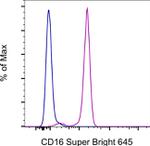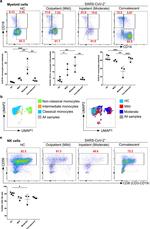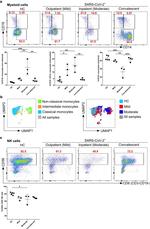Search Thermo Fisher Scientific
Invitrogen
CD16 Monoclonal Antibody (3G8), Super Bright™ 645, eBioscience™
FIGURE: 1 / 3
CD16 Antibody (64-0166-42) in Flow



Product Details
64-0166-42
Species Reactivity
Published species
Host/Isotype
Recommended Isotype Control
Class
Type
Clone
Conjugate
Excitation/Emission Max
Form
Concentration
Purification
Storage buffer
Contains
Storage conditions
Shipping conditions
RRID
Product Specific Information
Description: This 3G8 monoclonal antibody reacts with human and non-human primate CD16, which is also known as the low-affinity Fc gamma RIII. CD16 exists as two distinct isoforms, Fc gamma RIIIA and Fc gamma RIIIB. In humans, Fc gamma RIIIA is expressed as a polypeptide-anchored form on monocytes, macrophages, and lymphocytes such as NK cells. T and B cells do not express this Fc receptor. Fc gamma RIIIB is also detected on neutrophils as a GPI-anchored form. Expression of CD16 on lymphocytes and monocytes is similar in non-human primates. However, while CD16 is not found on neutrophils in macaques and baboons, this receptor is detected on these cells in sooty mangabeys. Binding of IgG leads to activation of signal transduction pathways, resulting in antibody-dependent cell-mediated cytotoxicity (ADCC), phagocytosis, cytokine release, and antigen presentation.
Based on cross-blocking studies 3G8 recognizes the same epitope as CB16. However, 3G8 and B73.1 antibody clones bind distinct epitopes.
Applications Reported: This 3G8 antibody has been reported for use in flow cytometric analysis.
Applications Tested: This 3G8 antibody has been pre-diluted and tested by flow cytometric analysis of normal human peripheral blood cells. This may be used at 5 µL (0.125 µg) per test. A test is defined as the amount (µg) of antibody that will stain a cell sample in a final volume of 100 µL. Cell number should be determined empirically but can range from 10^5 to 10^8 cells/test.
Super Bright 645 is a tandem dye that can be excited with the violet laser line (405 nm) and emits at 645 nm. We recommend using a 660/20 bandpass filter. Please make sure that your instrument is capable of detecting this fluorochrome.
When using two or more Super Bright dye-conjugated antibodies in a staining panel, it is recommended to use Super Bright Complete Staining Buffer (Product # SB-4401) to minimize any non-specific polymer interactions. Please refer to the datasheet for Super Bright Staining Buffer for more information.
Light sensitivity: This tandem dye is sensitive to photo-induced oxidation. Please protect this vial and stained samples from light.
Fixation: Samples can be stored in IC Fixation Buffer (Product # 00-8222) (100 µL of cell sample + 100 µL of IC Fixation Buffer) or 1-step Fix/Lyse Solution (Product # 00-5333) for up to 3 days in the dark at 4°C with minimal impact on brightness and FRET efficiency/compensation. Some generalizations regarding fluorophore performance after fixation can be made, but clone specific performance should be determined empirically.
Excitation: 405 nm; Emission: 645 nm; Laser: Violet Laser
Super Bright Polymer Dyes are sold under license from Becton, Dickinson and Company.
Target Information
CD16 encodes a receptor that recognizes the Fc portion of immunoglobulin G and is involved in the clearance of immune complexes from the circulation, as well as other functions such as cellular mediated cytotoxicity and enhancement of virus infections. This gene, FCGR3A, shares a high degree of similarity with another nearby gene, FCGR3B, located on chromosome 1. The receptor encoded by this gene is expressed on natural killer (NK) cells as an integral membrane glycoprotein anchored through a transmembrane peptide, while FCGR3B is expressed on polymorphonuclear neutrophils (PMN) where the receptor is anchored through a phosphatidylinositol (PI) linkage. Mutations in this gene have been associated with immunodeficiency 20 and have been linked to susceptibility to recurrent viral infections, susceptibility to systemic lupus erythematosus, and alloimmune neonatal neutropenia. Alternatively spliced transcript variants encoding different isoforms have been found for this gene. Diseases associated with FCGR3A include Immunodeficiency 20 and Herpes Zoster.
For Research Use Only. Not for use in diagnostic procedures. Not for resale without express authorization.
How to use the Panel Builder
Watch the video to learn how to use the Invitrogen Flow Cytometry Panel Builder to build your next flow cytometry panel in 5 easy steps.
Bioinformatics
Protein Aliases: CD16-I; CD16-II; CD16a; CD16a antigen; CD16b; CD32 receptor 2; Fc fragment of IgG low affinity IIIa receptor; Fc fragment of IgG, low affinity III, receptor for (CD16); Fc fragment of IgG, low affinity IIIa, receptor (CD16a); Fc fragment of IgG, low affinity IIIb, receptor (CD16b); Fc gamma receptor III-A; Fc gamma receptor IIIa; Fc gamma receptor IIIb; Fc gamma RIIIa; Fc-gamma receptor III-2 (CD 16); Fc-gamma receptor IIIb (CD 16); Fc-gamma receptor IIIb (CD16); Fc-gamma RIII; Fc-gamma RIII-alpha; Fc-gamma RIII-beta; Fc-gamma RIIIa; fc-gamma RIIIb; FCG2; FcgammaRIIIA; FCGR2; FCGR2A; FCGR2B; FCGR2C; FcR-10; FcRII-b; FcRII-c; IgG Fc receptor III; IgG Fc receptor III-1; IgG Fc receptor III-2; IgG Fc receptor III-A; immunoglobulin G Fc receptor III; Low affinity immunoglobulin gamma Fc region receptor III-A; Low affinity immunoglobulin gamma Fc region receptor III-B; neutrophil-specific antigen NA; RP11-5K23.1
Gene Aliases: CD16; CD16A; CD16B; FCG3; FCGR3; FCGR3A; FCGR3B; FCGRIII; FCR-10; FCRIII; FCRIIIA; FCRIIIb; IGFR3; IMD20
UniProt ID: (Rhesus monkey) A3RFZ7, (Human) P08637, (Human) O75015
Entrez Gene ID: (Rhesus monkey) 720006, (Human) 2214, (Human) 2215

Performance Guarantee
If an Invitrogen™ antibody doesn't perform as described on our website or datasheet,we'll replace the product at no cost to you, or provide you with a credit for a future purchase.*
Learn more
We're here to help
Get expert recommendations for common problems or connect directly with an on staff expert for technical assistance related to applications, equipment and general product use.
Contact tech support

